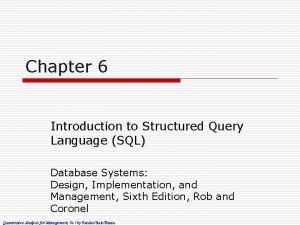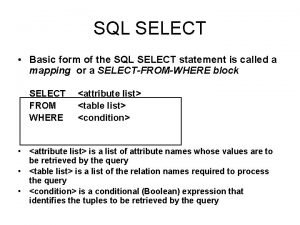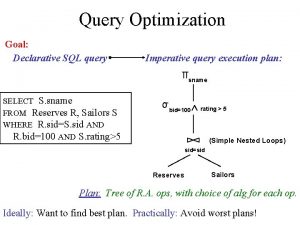SQL The Query Language Part 2 Lecture 10








![Queries With GROUP BY and HAVING SELECT [DISTINCT] target-list FROM relation-list WHERE qualification GROUP Queries With GROUP BY and HAVING SELECT [DISTINCT] target-list FROM relation-list WHERE qualification GROUP](https://slidetodoc.com/presentation_image/94e919097c55647983ddfafe27d6da1d/image-9.jpg)





![INSERT [INTO] table_name [(column_list)] VALUES ( value_list) INSERT [INTO] table_name [(column_list)] <select statement> INSERT INSERT [INTO] table_name [(column_list)] VALUES ( value_list) INSERT [INTO] table_name [(column_list)] <select statement> INSERT](https://slidetodoc.com/presentation_image/94e919097c55647983ddfafe27d6da1d/image-15.jpg)
![DELETE & UPDATE DELETE [FROM] table_name [WHERE qualification] DELETE FROM Boats WHERE color = DELETE & UPDATE DELETE [FROM] table_name [WHERE qualification] DELETE FROM Boats WHERE color =](https://slidetodoc.com/presentation_image/94e919097c55647983ddfafe27d6da1d/image-16.jpg)

![Joins SELECT (column_list) FROM table_name [INNER | {LEFT |RIGHT | FULL } OUTER] JOIN Joins SELECT (column_list) FROM table_name [INNER | {LEFT |RIGHT | FULL } OUTER] JOIN](https://slidetodoc.com/presentation_image/94e919097c55647983ddfafe27d6da1d/image-18.jpg)










- Slides: 28

SQL: The Query Language Part 2 Lecture 10 R & G - Chapter 5 The important thing is not to stop questioning. Albert Einstein

Reserves Example Instances Sailors Boats

Queries With GROUP BY • To generate values for a column based on groups of rows, use aggregate functions in SELECT statements with the GROUP BY clause SELECT [DISTINCT] target-list FROM relation-list [WHERE qualification] GROUP BY grouping-list The target-list contains (i) list of column names & (ii) terms with aggregate operations (e. g. , MIN (S. age)). – column name list (i) can contain only attributes from the grouping-list.

Group By Examples For each rating, find the average of the sailors SELECT S. rating, AVG FROM Sailors S GROUP BY S. rating (S. age) For each rating find the age of the youngest sailor with age 18 SELECT S. rating, MIN FROM Sailors S WHERE S. age >= 18 GROUP BY S. rating (S. age)

Conceptual Evaluation • The cross-product of relation-list is computed, tuples that fail qualification are discarded, `unnecessary’ fields are deleted, and the remaining tuples are partitioned into groups by the value of attributes in grouping-list. • One answer tuple is generated per qualifying group.

SELECT S. rating, MIN FROM Sailors S WHERE S. age >= 18 GROUP BY S. rating (S. age) Answer Table 3. Perform Aggregati 1. Form cross product 2. Delete unneeded columns, rows; form groups

Find the number of reservations for each red boat. SELECT B. bid, COUNT(*)AS numres FROM Boats B, Reserves R WHERE R. bid=B. bid AND B. color=‘red’ GROUP BY B. bid • Grouping over a join of two relations.

SELECT B. bid, COUNT (*) AS scount FROM Boats B, Reserves R WHERE R. bid=B. bid AND B. color=‘red’ GROUP BY B. bid 1 2 answer
![Queries With GROUP BY and HAVING SELECT DISTINCT targetlist FROM relationlist WHERE qualification GROUP Queries With GROUP BY and HAVING SELECT [DISTINCT] target-list FROM relation-list WHERE qualification GROUP](https://slidetodoc.com/presentation_image/94e919097c55647983ddfafe27d6da1d/image-9.jpg)
Queries With GROUP BY and HAVING SELECT [DISTINCT] target-list FROM relation-list WHERE qualification GROUP BY grouping-list HAVING group-qualification • Use the HAVING clause with the GROUP BY clause to restrict which group-rows are returned in the result set

Conceptual Evaluation • Form groups as before. • The group-qualification is then applied to eliminate some groups. – Expressions in group-qualification must have a single value per group! – That is, attributes in group-qualification must be arguments of an aggregate op or must also appear in the grouping-list. (SQL does not exploit primary key semantics here!) • One answer tuple is generated per qualifying group.

Find the age of the youngest sailor with age 18, for each rating with at least 2 such sailors SELECT S. rating, MIN (S. age) FROM Sailors S WHERE S. age >= 18 GROUP BY S. rating HAVING COUNT (*) > 1 2 3 Answer relation

Find sailors who’ve reserved all boats. SELECT S. sname Sailors S such that. . . FROM Sailors S WHERE NOT EXISTS (SELECT B. bid there is no boat B without. . . FROM Boats B WHERE NOT EXISTS (SELECT R. bid FROM Reserves R a Reserves tuple showing S reserved B WHERE R. bid=B. bid AND R. sid=S. sid))

Find sailors who’ve reserved all boats. • Can you do this using Group By and Having? SELECT S. name FROM Sailors S, reserves R WHERE S. sid = R. sid GROUP BY S. name, S. sid HAVING COUNT(DISTINCT R. bid) = ( Select COUNT (*) FROM Boats) Note: must have both sid and name in the GROUP BY clause. Why?

SELECT S. name, S. sid FROM Sailors S, reserves R WHERE S. sid = r. sid GROUP BY S. name, S. sid HAVING COUNT(DISTINCT R. bid) = Select COUNT (*) FROM Boats Count (*) from boats = 4 Apply having clause to groups
![INSERT INTO tablename columnlist VALUES valuelist INSERT INTO tablename columnlist select statement INSERT INSERT [INTO] table_name [(column_list)] VALUES ( value_list) INSERT [INTO] table_name [(column_list)] <select statement> INSERT](https://slidetodoc.com/presentation_image/94e919097c55647983ddfafe27d6da1d/image-15.jpg)
INSERT [INTO] table_name [(column_list)] VALUES ( value_list) INSERT [INTO] table_name [(column_list)] <select statement> INSERT INTO Boats VALUES ( 105, ‘Clipper’, ‘purple’) INSERT INTO Boats (bid, color) VALUES (99, ‘yellow’) You can also do a “bulk insert” of values from one table into another: INSERT INTO TEMP(bid) SELECT r. bid FROM Reserves R WHERE r. sid = 22; (must be type compatible)
![DELETE UPDATE DELETE FROM tablename WHERE qualification DELETE FROM Boats WHERE color DELETE & UPDATE DELETE [FROM] table_name [WHERE qualification] DELETE FROM Boats WHERE color =](https://slidetodoc.com/presentation_image/94e919097c55647983ddfafe27d6da1d/image-16.jpg)
DELETE & UPDATE DELETE [FROM] table_name [WHERE qualification] DELETE FROM Boats WHERE color = ‘red’ DELETE FROM Boats b WHERE b. bid = (SELECT r. bid FROM Reserves R WHERE r. sid = 22) Can also modify tuples using UPDATE statement. UPDATE Boats SET Color = “green” WHERE bid = 103;

Null Values • Field values in a tuple are sometimes unknown (e. g. , a rating has not been assigned) or inapplicable (e. g. , no spouse’s name). – SQL provides a special value null for such situations. • The presence of null complicates many issues. E. g. : – Special operators needed to check if value is/is not null. – Is rating>8 true or false when rating is equal to null? What about AND, OR and NOT connectives? – We need a 3 -valued logic (true, false and unknown). – Meaning of constructs must be defined carefully. (e. g. , WHERE clause eliminates rows that don’t evaluate to true. ) – New operators (in particular, outer joins) possible/needed.
![Joins SELECT columnlist FROM tablename INNER LEFT RIGHT FULL OUTER JOIN Joins SELECT (column_list) FROM table_name [INNER | {LEFT |RIGHT | FULL } OUTER] JOIN](https://slidetodoc.com/presentation_image/94e919097c55647983ddfafe27d6da1d/image-18.jpg)
Joins SELECT (column_list) FROM table_name [INNER | {LEFT |RIGHT | FULL } OUTER] JOIN table_name ON qualification_list WHERE … Explicit join semantics needed unless it is an INNER join (INNER is default)

Inner Join Only the rows that match the search conditions are returned. SELECT s. sid, s. name, r. bid FROM Sailors s INNER JOIN Reserves r ON s. sid = r. sid Returns only those sailors who have reserved boats SQL-92 also allows: SELECT s. sid, s. name, r. bid FROM Sailors s NATURAL JOIN Reserves r “NATURAL” means equi-join for each pair of attributes with the same name

SELECT s. sid, s. name, r. bid FROM Sailors s INNER JOIN Reserves r ON s. sid = r. sid

Left Outer Join returns all matched rows, plus all unmatched rows from the table on the left of the join clause (use nulls in fields of non-matching tuples) SELECT s. sid, s. name, r. bid FROM Sailors s LEFT OUTER JOIN Reserves r ON s. sid = r. sid Returns all sailors & information on whether they have reserved boats

SELECT s. sid, s. name, r. bid FROM Sailors s LEFT OUTER JOIN Reserves r ON s. sid = r. sid

Right Outer Join returns all matched rows, plus all unmatched rows from the table on the right of the join clause SELECT r. sid, b. bid, b. name FROM Reserves r RIGHT OUTER JOIN Boats b ON r. bid = b. bid Returns all boats & information on which ones are reserved.

SELECT r. sid, b. bid, b. name FROM Reserves r RIGHT OUTER JOIN Boats b ON r. bid = b. bid

Full Outer Join returns all (matched or unmatched) rows from the tables on both sides of the join clause SELECT r. sid, b. bid, b. name FROM Reserves r FULL OUTER JOIN Boats b ON r. bid = b. bid Returns all boats & all information on reservations

SELECT r. sid, b. bid, b. name FROM Reserves r FULL OUTER JOIN Boats b ON r. bid = b. bid Note: in this case it is the same as the ROJ because bid is a foreign key in reserves, so all reservations must have a corresponding tuple in boats.

Views CREATE VIEW view_name AS select_statement Makes development simpler Often used for security Not instantiated - makes updates tricky CREATE VIEW Reds AS SELECT B. bid, COUNT (*) AS scount FROM Boats B, Reserves R WHERE R. bid=B. bid AND B. color=‘red’ GROUP BY B. bid

CREATE VIEW Reds AS SELECT B. bid, COUNT (*) AS scount FROM Boats B, Reserves R WHERE R. bid=B. bid AND B. color=‘red’ GROUP BY B. bid Reds
 Lir
Lir Introduction to structured query language (sql)
Introduction to structured query language (sql) Introduction to structured query language (sql)
Introduction to structured query language (sql) Singkatan dari structured query language adalah
Singkatan dari structured query language adalah A structured query language – sql operators are
A structured query language – sql operators are Sql stands for structured query language
Sql stands for structured query language Update sql command
Update sql command Structured query language (sql) is an example of a(n)
Structured query language (sql) is an example of a(n) Sql nn
Sql nn Iterative query vs recursive query
Iterative query vs recursive query Query tree and query graph
Query tree and query graph Query tree and query graph
Query tree and query graph Inside the sql server query optimizer
Inside the sql server query optimizer Sql injection
Sql injection Sqlstress
Sqlstress Inside the sql server query optimizer
Inside the sql server query optimizer Whoisactive sql query
Whoisactive sql query Sql insert update delete query
Sql insert update delete query Shrpe
Shrpe Sql query
Sql query Cosmos db query optimization
Cosmos db query optimization Excel sql query
Excel sql query Sql query for xml
Sql query for xml Sql server intelligent query processing
Sql server intelligent query processing 01:640:244 lecture notes - lecture 15: plat, idah, farad
01:640:244 lecture notes - lecture 15: plat, idah, farad Set serveroutput on
Set serveroutput on Pl/sql unit testing
Pl/sql unit testing My structured query language
My structured query language Oql query examples
Oql query examples

















































